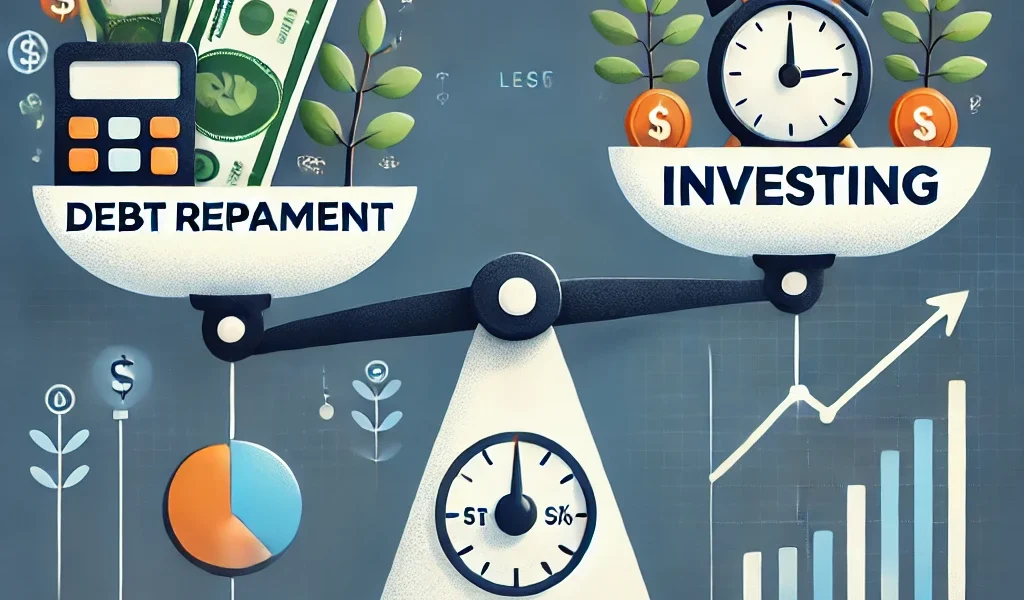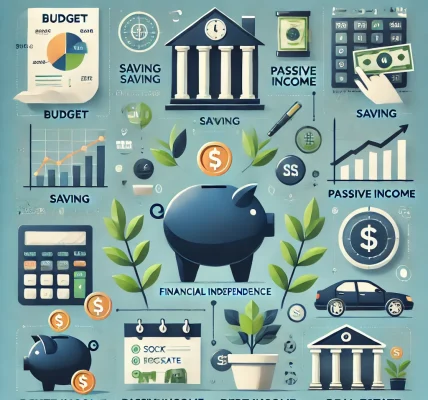Introduction
Managing personal finances can be a tricky balancing act, especially when it comes to debt repayment and investing for the future. Many people struggle with the question: Should I pay off debt first or invest my money?
The answer depends on several factors, including interest rates, financial goals, risk tolerance, and income stability. In this guide, we’ll explore how to effectively balance paying off debt while still investing for your long-term financial security.
Understanding the Key Factors
1. Interest Rates: The Deciding Factor
- High-interest debt (above 7-8%): Prioritize paying off high-interest debt, such as credit cards and payday loans, before focusing on investing.
- Low-interest debt (below 5%): If your debt carries a low-interest rate, you may benefit from investing while making minimum debt payments.
- Moderate-interest debt (5-7%): This is a gray area where a hybrid approach (paying off debt while investing) may be ideal.
2. Employer 401(k) Match: Free Money You Shouldn’t Ignore
If your employer offers a 401(k) match, contribute at least enough to get the full match before prioritizing debt repayment. This is essentially “free money” that provides instant returns on your investment.
3. Emergency Fund: A Financial Safety Net
Before aggressively paying off debt or investing, ensure you have an emergency fund of at least 3-6 months’ worth of expenses. This will protect you from unexpected financial hardships without relying on credit cards.
4. Risk Tolerance and Financial Stability
- If you have a stable job and predictable income, you might feel comfortable taking on investment risks while managing debt.
- If your income is unpredictable, it’s wise to eliminate debt first to lower financial risk.
Debt Repayment vs. Investing: The Pros and Cons
✅ Paying Off Debt First
Pros:
- Guaranteed return: Eliminating debt is a risk-free way to improve your financial health.
- Lower stress: Reducing debt leads to financial peace of mind.
- Improved credit score: A lower debt burden improves creditworthiness.
Cons:
- Missed investment opportunities: Delaying investing means missing out on potential market growth.
- Lack of liquidity: Once money is used to pay off debt, it’s not available for emergencies or investments.
✅ Investing While Paying Off Debt
Pros:
- Compounding growth: Early investing allows money to grow exponentially over time.
- Tax advantages: Contributions to retirement accounts (e.g., 401(k), Roth IRA) may offer tax benefits.
- Diversified financial plan: Balancing debt repayment and investing creates financial flexibility.
Cons:
- Potential financial strain: Managing both debt and investments requires strict budgeting.
- Market risk: Investments are subject to market fluctuations and are not guaranteed.
The Best Strategy: A Balanced Approach
For most people, a balanced approach—paying off debt while also investing—is the best option. Here’s a step-by-step plan:
Step 1: Prioritize High-Interest Debt (Interest Rate > 7%)
- Pay off credit cards, payday loans, and personal loans as quickly as possible.
- Use the debt avalanche method (paying off the highest-interest debt first) to save money on interest.
Step 2: Contribute to Retirement Savings (If Employer Match is Available)
- If your employer offers a 401(k) match, contribute enough to get the full match.
- This is free money that provides immediate returns.
Step 3: Build a Small Emergency Fund
- Save at least 3-6 months of essential expenses in a high-yield savings account.
- This will prevent reliance on credit cards for unexpected costs.
Step 4: Pay Off Moderate-Interest Debt (5-7%) and Start Investing
- Begin investing in a Roth IRA or index funds while continuing to pay off debts like car loans and student loans.
- Allocate funds based on your comfort level—a 50/50 split between debt repayment and investing is a good strategy.
Step 5: Fully Pay Off Low-Interest Debt and Increase Investments
- Once higher-interest debts are gone, focus on increasing investment contributions to maximize wealth-building.
- Consider maxing out retirement accounts (401(k), Roth IRA) and investing in taxable brokerage accounts.
Best Investment Options While Managing Debt
If you’re balancing debt repayment with investing, here are some smart investment choices:
1. 401(k) and IRA Accounts (Best for Long-Term Growth)
- Employer-sponsored 401(k) with a match is the top priority.
- Roth IRA or Traditional IRA for tax-advantaged retirement savings.
2. Index Funds and ETFs (Best for Passive Growth)
- Low-cost index funds like S&P 500 ETFs provide diversified long-term growth.
- Ideal for beginners with limited investing knowledge.
3. High-Yield Savings Account (Best for Short-Term Safety)
- Keeps emergency funds accessible while earning some interest.
- Great for savings that may be needed in the near future.
4. Real Estate Investing (Best for Long-Term Wealth)
- If you’ve already paid off high-interest debt, real estate can be a passive income stream.
- Requires careful planning to avoid financial strain.
Mistakes to Avoid
❌ Paying Only the Minimum on High-Interest Debt
- This keeps you stuck in long-term debt cycles and results in excessive interest payments.
❌ Delaying Investing for Too Long
- The earlier you invest, the more compound interest works in your favor.
❌ Investing in Risky Assets While Carrying Debt
- Avoid high-risk investments (cryptocurrency, speculative stocks) if you have outstanding debt.
❌ Ignoring an Emergency Fund
- Without an emergency fund, you risk falling back into debt when unexpected expenses arise.
Conclusion
Balancing debt repayment and investing is key to achieving long-term financial stability. By following a strategic approach, you can:
- Eliminate high-interest debt quickly
- Take advantage of investment opportunities
- Build long-term wealth without financial stress




